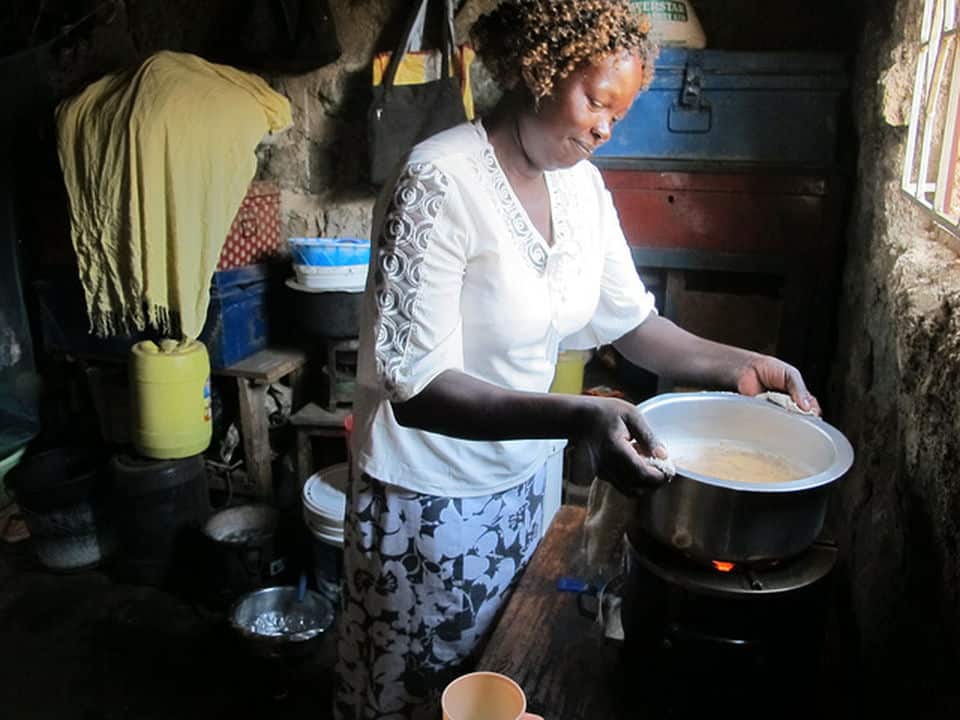In the 21st century, providing food for your family shouldn’t mean gambling with their lives. But that’s exactly what more than a third of women around the world are doing when they use wood, coal, charcoal or animal dung for cooking or heating.
By Sarah Butler-Sloss, Founder Director of Ashden
The Global Energy Crisis
The WHO recently reported that 4.3 million people die from the results of indoor air pollution – the majority of it from cooking smoke. That’s more than six times the number of people who die from malaria.
A fifth of the world’s population are also at risk of illness, burns or death because they use kerosene to light their homes after sunset. Kerosene is a major health hazard for two reasons: the toxic smoke it gives off, and the accidental fires that are so easily caused by knocking over kerosene lamps.
Inadequate lighting in the evening means educational opportunities for children are stymied too – it’s hard to do homework by the light of a candle or kerosene lamp.
Make no mistake, this is a global crisis. Yet so few people seem aware of it. Perhaps it’s because deaths aren’t immediate, and they are harder to attribute – you won’t find ‘inhaling smoke’ on any death certificate – though you will see pneumonia, strokes or lung cancer. There’s also no big event or visible catastrophe to draw the world’s attention or capture imaginations. And children not being able to do their homework at night is not newsworthy.
Why women are worst affected
Lack of access to clean energy is debilitating for women – not just for the obvious reason that women and girls tend to be at home more, so are likely to suffer more from the effects of inhaling cooking and kerosene fumes.
In most countries, women and girls are also the ones responsible for gathering cooking fuel, often trudging for hours every day to collect and carry bundles of wood or other fuels and then spending hours bent over smoky fires or stoves to cook the family meal.
This sucks up vast amounts of time that could be far better spent in education, income-generating work – or simply socialising. In many countries, particularly in areas of conflict, travelling long distances to gather fuel also exposes women to risk of violence or sexual assault.
It’s also women and girls who, without access to radio or TV, remain trapped in traditional roles, with no alternative role models to aspire to. And because of their position in the family as care-giver, it’s also women who carry the greatest burden of worry about their children’s wellbeing.
The great irony of all this is that while women are worse off than men from lack of energy, few of them are involved in the sector. Across the world, energy has traditionally been a masculine sphere. The vast majority of people who work in the traditional energy sector are men – not just running the big energy companies, but installing the supply and distribution infrastructure.
Promoting access to clean energy
The growth of new, sustainable energy solutions is beginning to change all this.
Modern stoves and cleaner fuels for cooking and heating relieve women from the time-consuming drudgery and danger of travelling long distances to gather wood, as well as saving time cooking and cleaning pots. There are growing numbers of socially oriented businesses around the world doing this – developing stoves that are affordable, accessible and aspirational for women.
There is also an increasing number of for-profit businesses and charities that are demonstrating huge creativity and ingenuity in increasing access to solar electricity in some of the remotest areas in the world. Solar-powered electricity means girls can study after dark and their mothers have the opportunity to do income generating activities. It allows mobile phones to be charged, giving access not just to calls and texts, but internet and mobile money and information about the wider world.
Even more importantly, sustainable energy can provide new opportunities for women’s empowerment by breaking down the barriers to their involvement in the provision of energy.
We’re seeing many more examples of women leading clean energy businesses, and of businesses training women to sell clean cookstoves and solar equipment – and in some cases, install and repair equipment too. This is helping erode concepts of what constitutes an ‘appropriate’ job for a woman, at the same time as boosting their confidence and self-esteem. The two finalists for the 2014 Ashden Clean Energy for Women and Girls Award, Greenway Grameen and the Sakhi Unique Rural Enterprise are both fantastic examples of this new movement.
Making sure energy for women is on the global sustainable development agenda
The recent announcement by the International Sustainable Energy for All Initiative that the first two years of the 2014-24 Decade of Energy Access for All will focus on women and girls provides further hope for a renewed focus on energy for women.
Right now, the proposed new Sustainable Development Goals, designed to set the world on a more sustainable development path, are currently under development. These are set to replace the internationally negotiated Millennium Development Goals, which expire in 2015. It is critical that these goals include specific, timed targets to increase women and girls’ access to clean cooking and electricity.
We must not miss this opportunity to place the empowerment of women through energy access firmly on the international development agenda.
Our #Volts4Women campaign, timed to coincide with our international conference on 20 May, aims to raise awareness of this issue, which for so long has been neglected. We want to make sure that energy for women and girls is firmly on the international development agenda – and stays there. Please help us spread the word about women’s need for clean energy. Help give women power.
This article was first published by Green Futures magazine.
Greenway Grameen and the Sakhi Unique Rural Enterprise are finalists for the 2014 International Ashden Awards.
Follow @Volts4Women on twitter

